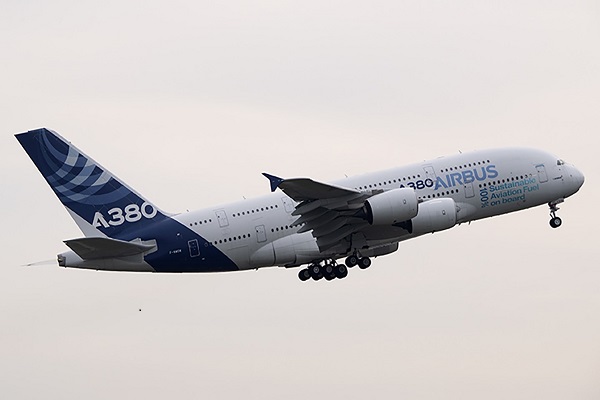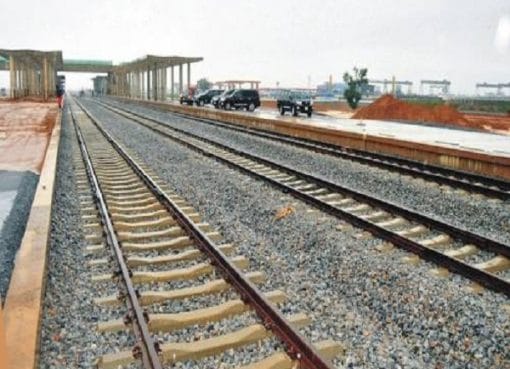The world’s largest passenger airliner has completed a three-hour flight powered by cooking oil for the first time.
A test model of an Airbus A380 ‘superjumbo’ aircraft, which was filled with 27 tonnes of sustainable aviation fuel (SAF), took off from Blagnac Airport in Toulouse and landed in Nice.
It became the first ever A380 flight to be 100 per cent powered by SAF and the third time an Airbus aircraft has completed the feat over the past year.
The aviation industry has pledged to achieve net-zero carbon emissions by 2050, while the UK Government has set a target of aircraft using 10 per cent SAF by 2030.
The fuel, which cuts CO2 emissions by up to 80 per cent, can be made from waste oil and fats, green and municipal waste and non-food crops.
It became the first ever A380 flight to be 100 per cent powered by SAF and the third time an Airbus aircraft has completed the feat over the past year
New jet engines can take up to 50 per cent green jet fuel, but Rolls-Royce said its Trent engines could be 100 per cent powered by sustainable fuel by 2023.
Airbus’ A380 double-decker test aircraft MSN 1 took off at 07:43 (GMT) on Friday, March 25, operating one Rolls-Royce Trent 900 engine on 100 per cent SAF.
This was made in Normandy by TotalEnergies and consisted of Hydroprocessed Esters and Fatty Acids (HEFA), free of aromatics and sulphur.
The jet was the third Airbus aircraft type to fly on 100 per cent SAF over the course of 12 months; the first was an Airbus A350 in March 2021 followed by an A319neo single-aisle aircraft in October 2021.
The airline industry body IATA estimates that SAF could provide 65 per cent of the reduction in emissions needed by the sector to reach net zero by 2050.
However, green jet fuel is up to five times dearer than conventional jet fuel, and represents one per cent of aviation fuel used globally.
The cost could mean higher air fares unless the Government offers financial support, such as subsidies similar to those used to kickstart the offshore wind sector, a loan guarantee scheme to underwrite lending used to finance the production of green jet fuel, using revenue from air passenger duty or an emissions trading scheme.
Government involvement could unleash backing from City investors to reach the target of building 13 sustainable aviation fuel plants by 2030, each costing £300 million.
The UK Government has said the sustainable aviation fuel sector could create 6,500 jobs by the mid-2030s and boost the economy by £900 million.
Airbus said that all of its aircraft were currently certified to fly with up to a 50 per cent blend of SAF mixed with kerosene.
‘Increasing the use of SAF remains a key pathway to achieving the industry’s ambition of netzero carbon emissions by 2050,’ Airbus added in a statement.
The company claims that flying planes on SAF could net between 53 per cent to 71 per cent of the carbon reductions required to meet that goal.
Global demand for jet fuel currently totals roughly 200 billion litres a year, but airline trade group IATA estimates just 100 million to 120 million litres of SAF will be produced in 2021, which is only 0.05 per cent of overall fuel.
Planes and engines capable of running without fossil fuels are being planned for around 2025 and 2030, depending on the model.
 In December 2021, the final Airbus A380 ever to be built was handed over to its new owners, the Dubai-based carrier Emirates
In December 2021, the final Airbus A380 ever to be built was handed over to its new owners, the Dubai-based carrier EmiratesIn August last year the Biden administration announced that it was looking to wean aircraft off fossil fuels by 2050 as part of the White House’s broader push to fight climate change.
The US President’s team has discussed incentives and targets to increase SAF, but it is not taking the same approach as European governments that are seeking to force suppliers to blend rising amounts of SAF into their kerosene — a move opposed by US airlines.
In December 2021, the final Airbus A380 ever to be built was handed over to its new owners, the Dubai-based carrier Emirates.
The airline, which owns roughly half of the A380 fleet, looks set to continue using it for many years to come but several others stopped using the model during the pandemic.
The A380 carries 545 passengers, although in theory it can hold a maximum of 853.
The double-decker jet has four engines, an 260ft (80m) wingspan and a maximum take-off weight of 560 tonnes.










